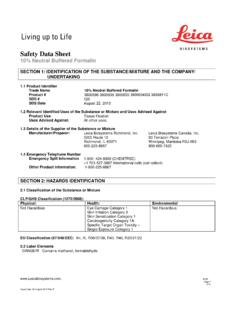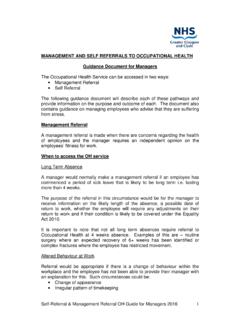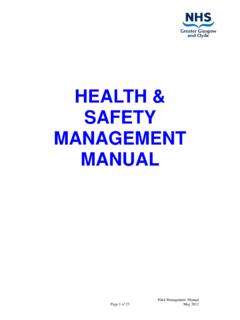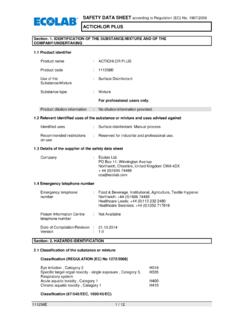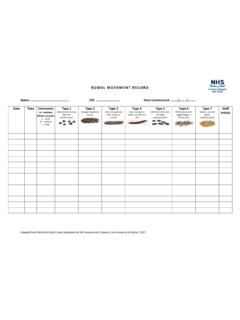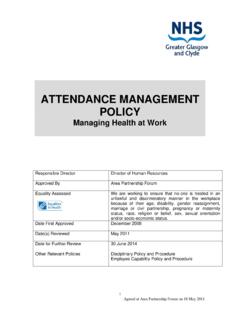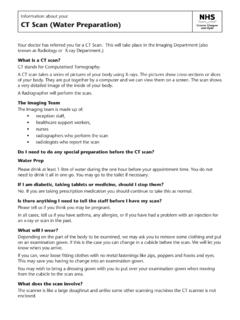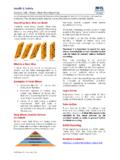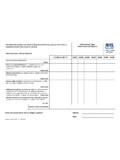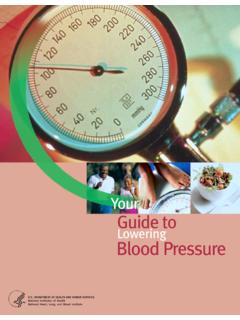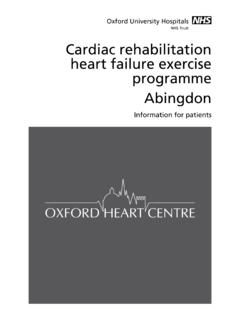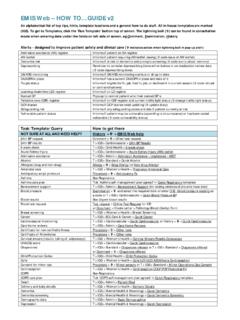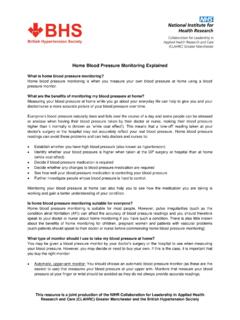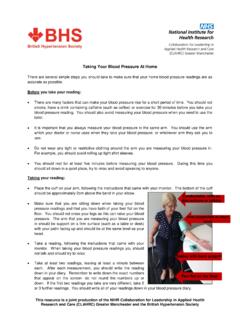Transcription of Bowel Management, Community Nursing
1 CLINICAL GUIDELINE. Bowel Management, Community Nursing A guideline is intended to assist healthcare professionals in the choice of disease-specific treatments. Clinical judgement should be exercised on the applicability of any guideline, influenced by individual patient characteristics. Clinicians should be mindful of the potential for harmful polypharmacy and increased susceptibility to adverse drug reactions in patients with multiple morbidities or frailty. If, after discussion with the patient or carer, there are good reasons for not following a guideline, it is good practice to record these and communicate them to others involved in the care of the patient. st Original Date of Approval: 1 November 2014. th Date of Update: 19 October 2017. st Review Date: 31 October 2020. Lead Author: Jacqui Fordyce Approval Group: Partnership Clinical Governance Forum Clinical Content Changes (Y/N): No Version no: 2.
2 Contents Pg No Summary 3. Introduction 5. Types of Constipation 6. Further investigation and specialist treatment 6. Who is at risk of constipation 7. Causes of Constipation 8. Management of constipation in adults 9. General management flow chart' 11. Formulary drug choices 12. Table illustrating formulary drug choices 17. Education & Training 20. References 20. Useful contacts 20. Appendix 1 - Risk assessment Tool 21. Appendix 2 Fibre ideas 22. Appendix 3 Fluid index matrix 23. Appendix 4 Bowel habit diary 24. Appendix 5 Food and fluid record diary 26. Appendix 6 Management of Constipation in Palliative Care 27. Appendix 7 Bristol Stool Chart 29. Appendix 8 Management of Adult Constipation by Nurses trained in Digital Rectal 30. Examination (DRE). Appendix 9- Phosphate enema additional guidance 31. Appendix 10- SPHERE Continence Care Team 32. NHS GG&C has made every effort to ensure this guideline does not have the effect of discriminating, directly or indirectly, against employees, patients, contractors or visitors on grounds of race, colour, age, nationality, ethnic (or national) origin, sex, sexual orientation, marital status, religious belief or disability.
3 This guideline will apply equally to full and part time employees. All NHSGG&C guidelines can be provided in large print or Braille formats if requested, and language line interpreter services are available to individuals of different nationalities who require them. 2. Summary A previous guidance document was published by NHS Greater Glasgow in 2014. It was widely distributed to District Nursing (DN) Teams. Constipation can be a distressing symptom, severity can vary from slight, causing no disruption to daily life, to severe, affecting physical, psychological and social well-being. Overcoming communication barriers associated with open discussion of Bowel habits and other sensitive gastro intestinal related symptoms is a skill required and one to be developed in all care settings. The management of constipation in palliative care is an addition to the original document as is the inclusion of the recommended formulary drugs to help manage and alleviate symptoms of constipation (NHSGG&C Therapeutics Handbook).
4 Related NHS GG & C Documents Guidelines on Management of Continence in Adults. Guidelines for the drug treatment of pain in primary care. Medication Review Best Practice Guidelines. NHSGG&C Therapeutics Handbook. A handbook for prescribing in adults 2014 (Access via Staffnet). NHSGG&C Formulary (Access via Staffnet). NHSGG&C Guidelines for Bowel management (2014). GG&C Palliative care guidelines on Staffnet Relevant National Documents RCN Caring for people with colorectal problems (2002). Guideline for management of neurogenic Bowel dysfunction after spinal cord injury (2009). RCN management of lower Bowel dysfunction, including DRE and DRF (2012). NICE; faecal incontinence (2007). Guidelines for Management of Neurogenic Bowel Dysfunction in Individuals with Central Neurological Conditions (2012). Caring for Stoma Patients, Best Practice Guidelines. CREST (2006, RCN Accredited till 2009).
5 3. Consultation Dieticians, SPHERE Bowel and Bladder Service, District Nursing Teams, General Practitioners, Palliative Care Teams, CHP Prescribing Advisors. To be reviewed in 2 years by Professional Standards and Clinical Guidelines Group. Scope This guidance does not apply to children or people below the age of 18 years of age. Clinical Audit It is recommended that these Guidelines be audited within three years of date of approval. 4. Introduction Constipation can be a symptom of many diseases and disorders. The management of constipation is a challenge for all healthcare professionals. The importance of educating and training all members of the healthcare team, including care assistants in residential and Nursing homes, in the management of Bowel care is important. An evidence based approach using a risk assessment tool, management of constipation flow chart, preventative and treatment guidelines should facilitate good practice across NHSGG&C.
6 If left untreated constipation may lead to rectal loading/ faecal impaction, or even faecal incontinence as a result of the impacted Bowel . Constipation requires immediate assessment if accompanied by symptoms of undiagnosed rectal bleeding, weight loss, abdominal pain and vomiting as may be indicative of colorectal cancer and it is advisable to seek guidance from your GP as soon as possible. A definition of constipation Bowel habits vary from one person to, another. The British National Formulary suggests the passage of hard stools less frequently than the patient's own normal pattern . The definition of constipation differs from patients and perspectives. A consensual definition has been developed based on quantitative criteria assessing defecation difficulties and stool frequency (Rome II criteria). According to this definition, constipation is diagnosed when at least two out of the following six criteria are present for at least 12 weeks in the preceding 12 months.
7 Straining during at least 25% of Bowel movements Pellet-like or hard stools for at least 25% of Bowel movements Sensation of incomplete evacuation for at least 25% of Bowel movements Sensation of anal blockage for at least 25% of Bowel movements Using manual manoeuvres (including digital evacuation or pressure on the perineum) to facilitate more than 25% of Bowel movements Having fewer than three Bowel movements per week Applying this standardised definition and using quantitative criteria should become a necessary first step in the management of patients that would help in guiding treatment and monitoring progress. However in summary constipation can most easily be defined as a variation in an individual's normal Bowel function. People's perceptions of constipation vary greatly and normal Bowel function may involve defecation three times daily or once every three days, but diagnosis may take place when there is a marked reduction in the amount of stools and/or reduced frequency of defecation.
8 5. Types of Constipation Chronic - Long standing constipation either because of medication or long term condition. Acute - Constipation has suddenly occurred either because of holiday, antibiotic therapy, surgery, pregnancy, inadequate fluid and/or fibre intake. This can be changed through lifestyle modification. Impacted - The constipated stool is lodged in the colon (descending, transverse, ascending) requires oral and rectal medication to alleviate the problem. Idiopathic Idiopathic constipation is when the Bowel is underactive and can be termed functional constipation. The condition tends to start in childhood and persists throughout life and there is no known cause. Specialist advice is recommended. Further Investigation & Specialist Treatment Referral for further investigation is essential if patients present with any of the following red flag'. symptoms. Change in Bowel habit from own normal pattern for more than 6 weeks.
9 Undiagnosed rectal bleeding. Abdominal pain. Passing mucus or blood per rectum. Unintentional anorexia and weight loss. A family history of Bowel or ovarian cancer In addition the early detection of colorectal cancer in primary care patients over 45 years needs to be considered. All healthcare professionals Are responsible and accountable for their own practice in relation to the assessment and management of patient's with constipation (NMC Code of Conduct (2008), NMC Standards for Medication (2010) and NMC Standards of Proficiency for Nurse and Midwife Prescribers (2006)). In addition, all staff should be aware of the National Occupational Standards relating to continence care and familiarize themselves with these competencies. Will initiate simple treatment and health promotion activities to maintain continence and promote self care. 6. Who is at Risk of Suffering from Constipation?
10 People at risk of constipation include: Those taking more than five prescribed medications. Those taking individual medications likely to cause constipation, anticholinergic drugs, opiate analgesics, iron, nifedipine/verapamil, aluminium containing antacids or calcium containing preparations. Frail elderly or immobile younger adults. Nursing home or care home residents. Patients with Parkinson's disease, multiple sclerosis, spinal cord disease or injury, stroke, diabetes mellitus, chronic renal failure, clinical dehydration. Patients with hypothyroidism, uraemia, hypocalcaemia or hypercalceamia. Patients with learning disabilities or cognitive impairment, dementia, Alzheimer's. Terminally ill or palliative care patients. Post-operative patients. Pregnant or post-natal women. Lack of teeth or poorly fitting dentures, swallowing difficulties. In addition patients with Coronary Heart Disease with constipation are at a higher risk of cardio vascular events if straining on the toilet.

